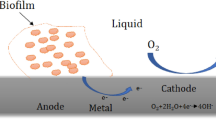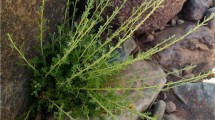Abstract
The present study evaluates, the oxidation behaviour of thermophilic bacteria Geobacillus thermoparaffinivorans IR2, Geobacillus stearothermophillus IR4 and Bacillus licheniformis MN6 on carbon steel API 5 LX by weight loss, electrochemical studies (impedance and polarization analysis) and surface analysis (X-ray diffraction spectroscopy). The presence of IR2, IR4 and MN6 showed highest corrosion rate (CR) of 2.51, 2.82 and 2.41 mm/year, respectively, than the abiotic control (0.95 mm/year). Whereas in the presence of biocide tetrakis (hydroxymethyl) phosphonium sulphate (THPS) inhibition of the biofilm formation was noticed on the carbon steel and thus reduced the CR of about 0.36, 0.46 and 0.42 mm/year. The electrochemical studies also revealed that higher charge transfer resistance (105 Ω cm2) and solution resistance (6.99 Ω cm2) in the presence of THPS due to the intact protective film on carbon steel surface. Thus, THPS is found to act as an effective candidate towards control microbial influenced corrosion by thermophilic bacteria on carbon steel API5LX in a 36% chloride environment.




Similar content being viewed by others
References
Beech IB, Gaylarde CC (1999) Recent advances in the study of biocorrosion: an overview. Rev Microbiol 30:177–190
Beech IB, Sunner J (2004) Biocorrosion: towards understanding interactions between biofilms and metals. Curr Opin Biotechnol 15:181–186
Boivin J (1994) Oil industry biocides. Mater Perf 34(2):65–68
Bolton N, Critchley M, Fabien R, Cromar N, Fallowfield H (2010) Microbially influenced corrosion of galvanized steel pipes in aerobic water systems. J Appl Microbiol 109:239–247
Busalmen JP, Vazquenz M, de Sanchez SR (2002) New evidence on the catalase mechanism of microbial corrosion. Electrochem Acta 47:1857–1865
Campanac C, Pineau L, Payard A, Baziard-Mouysset G, Roques C (2002) Interactions between biocide cationic agents and bacterial biofilms. Antimicrob Agents Chemother 46:1469–1474
Cote C, Rosasa O, Sztyler M, Doma J, Beech I, Basseguy R (2014) Corrosion of low carbon steel by microorganisms from the ‘pigging’ operation debris in water injection pipelines. Bioelectrochemistry 97:97–109
Efremenko E, Azizov R, Makhlis T, Abbasov V, Varfolomeev S (2005) Determination of minimal concentrations of biocorrosion inhibitors by a bioluminescence method. Appl Biochem Microbiol 41:377–410
Fink J (2011) Hydraulic fracturing chemicals and fluids technology. Gulf Professional Publishing, Houston
Gardner L, Stewart P (2002) Action of glutaraldehyde and nitrite against sulfatereducing bacterial biofilms. J Ind Microbiol Biotechnol 29:354–360
Hajj HE, Abdelouas A, El Mendili Y, Karakurt G, Grambow B, Martin C (2013) Corrosion of carbon steel under sequential aerobic–anaerobic environmental conditions. Corros Sci 76:432–440
Hamilton WA (1985) Sulphate reducing bacteria and anaerobic corrosion. Ann Rev Microbiol 39:195–217
Jack RF, Ringelberg DB, White DC (1992) Differential corrosion rates of carbon steel by combinations of Bacillus sp., Hafnia alvei and Desulfovibrio gigas established by phospholipid analysis of electrode biofilm. Corros Sci 33:1843–1853
Jan-Roblero J, Romero JM, Amaya M, Le Borgne S (2004) Phylogenetic characterization of a corrosive consortium isolated from a sour gas pipeline. Appl Microbiol Biotechnol 64:862–867
Jin J, Guan Y (2014) The mutual co-regulation of extracellular polymeric substances and iron ions in biocorrosion of cast iron pipes. Bioresour Technol 169:387–394
Johnson K, French K, Fichter JK, Oden R (2008) Use of microbiocides in Barnett shale gas well fracturing fluids to control bacteria related problems. Corrosion NACE International, New Orleans
Khalifa MA, El-Batouti M, Mahgoub F, Bakr Aknis A (2003) Corrosion inhibition of steel in crude oil storage tanks. Mater Corros 54:251–258
Lakshmi D, Rajendran S, Sathiabama JS (2016) Inhibition of corrosion of aluminium in aqueous solution at pH 11 by resorcinol-Zn2+ system. Int J Nano Corr Sci Engg 3(3):26–42
Lalpuria M, Karwa V, Anantheswaran RC, Floros JD (2013) Modified agar diffusion bioassay for better quantification of Nisaplin(®). J Appl Microbiol 114:663–671
Lebrini M, Bentiss F, Chihi NE, Jama C, Hornez JP, Lagrenee M (2008) Polyphosphate derivatives of guanidine and urea copolymer: inhibiting corrosion effect of armco iron in acid solution and antibacterial activity. Corros Sci 50:2914–2918
Lee J, Ray R, Lemieux E, Falster A, Little B (2004) An evaluation of carbon steel corrosion under stagnant sweater conditions. Biofouling 20:237–247
Liu JF, Mbadinga SM, Yang SZ, Gu JD, Mu BZ (2015) Chemical structure, property and potential applications of surfactants produced by Bacillus subtilis in petroleum recovery and spill mitigation. Int J Mol Sci 15:4814–4837
Marques JM, de Almeida FP, Lins U, Seldin L, Korenblum E (2012) Nitrate treatment effects on bacterial community biofilm formed on carbon steel in produced water stirred tank bioreactor. World J Microbiol Biotechnol 28:2355–2363
Marshall C, Frenzel P, Cypionka H (1993) Influence of oxygen on sulphate reduction and growth of sulphate reducing bacteria. Arch Microbiol 159:168–173
Moradi M, Duan J, Du X (2013) Investigation of the effect of 4,5-dichloro-2-n-octyl-4-isothiazolin-3-one inhibition on the corrosion of carbon steel in Bacillus sp. inoculated artificial seawater. Corros Sci 69:338–345
NACE (2002) Corrosion engineer reference book, NACE standard 3rd edition. Robert baboian; NACE 591 (National Association of Corrosion Engineers) International
Narenkumar J, Madhavan J, Nicoletti M, Benelli G, Murugan K, Rajasekar A (2016) Role of bacterial plasmid on biofilm formation and its influence on corrosion of engineering materials. J Bio Tribo Corros 2:24
Narenkumar J, Parthipan P, Nanthini AUR, Benelli G, Murugan K, Rajasekar A (2017) Ginger extract as green biocide to control microbial corrosion of mild steel 3. Biotech. doi:10.1007/s13205-017-0783-9
Nerie-Gonzalez I, Wang ET, Ramirez F, Romero JM, Hernandez-Rodrignez C (2006) Characterization of bacterial community associated to biofilms of corroded oil pipelines from the southeast of Mexico. Anaerobe 12:122–133
O’Tool GA, Pratt LA, Watnicr PI, Newman DK, Weaver VB, Kolter R (1999) Genetic approaches to study of biofilm. Methods Enzymol 310:91–109
Oliveira SH, Lima MAGA, Franc FP, Vieira MRS, Silva P, Filho SLU (2016) Control of microbiological corrosion on carbon steel with sodium hypochlorite and biopolymer. Int J Biol Macromol 88:27–35
Parthipan P, Babu TG, Anandkumar B, Rajasekar A (2017a) Biocorrosion and its impact on carbon steel API 5LX by Bacillus subtilis A1 and Bacillus cereus A4 isolated from Indian crude oil reservoir. J Bio Tribo Corros. doi:10.1007/s40735-017-0091-2
Parthipan P, Narenkumar J, Elumalai P, Preethi PS, Nanthini AUR, Agrawal A, Rajasekar A (2017b) Neem extract as a green inhibitor for microbiologically influenced corrosion of carbon steel API 5LX in a hypersaline environments. J Mol Liq 240:121–127
Qu Q, He Y, Wang L, Xu H, Lei L, Chen Y, Ding Z (2015) Corrosion behavior of cold rolled steel in artificial seawater in the presence of Bacillus subtilis C2. Corros Sci 91:321–329
Rajasekar A, Maruthamuthu S, Muthukumar N, Mohanan S, Subramanian P, Palaniswamy N (2005) Bacterial degradation of naphtha and its influence on corrosion. Corros Sci 47:257–271
Rajasekar A, Ponmariappan S, Maruthamuthu S, Palaniswamy N (2007) Bacterial degradation and corrosion of naphtha in transporting pipeline. Curr Microbiol 55:374–381
Rajasekar A, Anandkumar B, Maruthamuthu S, Ting YP, Rahman PKSM (2010) Characterization of corrosive bacterial consortia isolated from petroleum product transporting pipelines. Appl Microbiol Biotechnol 85:1175–1188
Shainy KM, Rugmini Ammal P, Unni KN, Benjamin S, Joseph A (2016) Surface interaction and corrosion inhibition of mild steel in hydrochloric acid using pyoverdine, an eco-friendly bio-molecule. J Bio Tribo Corros 2:20
Shanthy P, Rengan R, Thamarai Chelvan A, Rathika K, Rajendran S (2009) Corrosion inhibition and biocidal activity of a cationic surfactant. Indian J Chem Technol 16:328–333
Starosvetsky J, Starosvetsky D, Pokroy B, Hilel T, Armon R (2008) Electrochemical behaviour of stainless steels in media containing iron-oxidizing bacteria (IOB) by corrosion process modeling. Corros Sci 50(2):540–547
Struchtemeyer CG, Morrison MD, Elshahed MS (2012) A critical assessment of the efficacy of biocides used during the hydraulic fracturing process in shale natural gas wells. Int Biodeterior Biodegrad 71:15–21
Sung EH, Han JS, Ahn CM, Seo HJ, Kim CG (2011) Biological metal corrosion in saline systems by sulfur-reducing and iron-oxidizing bacteria. Water Qual Res J Can 46(4):321–331
Torres-Sanchez R, Magana-Vazquez A, Sanchez-Yanez JM, Gomez LM (1996) High temperature microbial corrosion in the condenser of a geothermal electric power unit. NACE International, Houston
Videla HA (2002) Prevention and control of biocorrosion. Int Biodeterior Biodegrad 49:259–270
Yeung CW, Law BA, Milligan TG, Lee K, Whyte LG, Greer CW (2011) Analysis of bacterial diversity and metals in produced water, seawater and sediments from an offshore oil and gas production platform. Mar Pollut Bull 62(10):2095–2105
Zhou Y (1990) Bactericide for drilling fluid. Drilling fluid and completion fluid 7(3):10–12
Acknowledgements
A. Rajasekar is thankful to the Department of Biotechnology (Government of India) for awarding Ramalingaswami re-entry Fellowship (BT/RLF/Re-entry/17/2012), Also acknowledge the Science and Engineering Research Board, Department of Science and Technology, Government of India (EEQ/2016/000449 and SB/YS/LS-40/2013) and University Grants Commission (MRP-MAJOR-MICRO-2013-31825).
Author information
Authors and Affiliations
Corresponding authors
Ethics declarations
Conflict of Interest
The authors declare that there is no conflict of interest regarding the publication of this paper.
Rights and permissions
About this article
Cite this article
Elumalai, P., Parthipan, P., Narenkumar, J. et al. Influence of Thermophilic Bacteria on Corrosion of Carbon Steel in Hyper Chloride Environment. Int J Environ Res 11, 339–347 (2017). https://doi.org/10.1007/s41742-017-0031-5
Received:
Revised:
Accepted:
Published:
Issue Date:
DOI: https://doi.org/10.1007/s41742-017-0031-5




